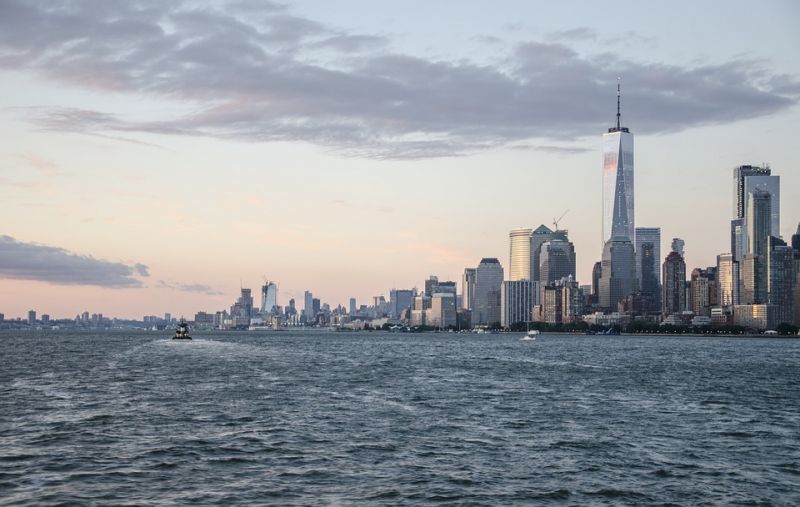Researchers Map High Levels of Drugs in the Hudson River
Published on by Water Network Research, Official research team of The Water Network in Academic
In a new study, researchers have mapped out a stew of discarded pharmaceuticals dissolved throughout the Hudson River. They say that in some places, levels may be high enough to affect aquatic life.
The research appears in the early online edition of the journal Water Research.

Hudson River, NYC, Source: Max Pixel, Labeled for reuse
This is not the first study to find pharmaceuticals in the Hudson, but it is the first to look at a wide variety, and chart their levels and distribution. In all, the researchers found 16 different pharmaceutical compounds, including antibiotics, drugs for treating high blood pressure, high cholesterol, epilepsy, ulcers and heartburn, and the common aspirin substitute acetaminophen. The medications are believed to enter the river through sewage outfalls after people excrete unmetabolized doses, or when people dump unused pills down the drain. The waters around New York City have high levels, but the researchers found even higher concentrations near more modest municipal outfalls of some upstate municipalities.
“Some levels are high enough that you could be concerned about fish and other aquatic organisms,” said Andrew Juhl, an aquatic biologist at Columbia University’s Lamont-Doherty Earth Observatory who coauthored the study. “Right now, we don’t know what the effects might be. Our point right now is to say these pharmaceuticals are there, and here’s the pattern throughout the river.”
The study was a collaboration among staff at the U.S. Environmental Protection Agency, the regional environmental group Riverkeeper, Lamont-Doherty and Queens College.
Pharmaceutical-related pollution is a well-known phenomenon. Researchers have been documenting the presence of drugs in surface waters in many places for the last 20 years or so. A 1999-2000 study by the U.S. Geological Survey found measureable amounts in 80 percent of water samples taken from 30 states. A 2008 investigation by the Associated Press found medications in the drinking water of some 40 million Americans. Recently, researchers spotted high concentrations of antidepressants in the brains of fish from the Niagara River.
Previous research by Cornell University has found pharmaceuticals in the Hudson, along with industrial compounds. Among other things, in 2013 Juhl and his colleagues also have documented the presence of bacteria resistant to common antibiotics in the river, probably also originating with sewage.
Juhl said the new study is a step toward understanding exactly how pharmaceuticals are distributed, and whether they might affect the river.
In the study, the researchers used Riverkeeper’s vessel to sample 72 sites along the river twice each, in May and July 2016. They started above Troy, where the Mohawk River feeds into the Hudson, and ended off the Battery in New York Harbor, covering about 155 miles. Some samples were taken in waterways connecting to the harbor, including the East River.
Testing for 16 highly prescribed drugs, they found traces of all in multiple places–an average of about half the list in each spot. These included the high-blood-pressure drugs atlenol (brand name Tenamin), diltiazem (Cardizem) and metoprolol (found in Lopressor and Toprol); the anti-ulcer medication ranitidine (Zantac); the anti-cholesterol drug gemfibrozil (Lopil); and carbamazepine (Tegretol), used to treat epilepsy. Acetaminophen, the active ingredient in Tylenol and other products, was widespread.
Different combinations occurred in different places, but overall, the blood-pressure drugs were the most common. The researchers also tested for two common non-medications that would be expected to be found in sewage: caffeine and the artificial sweetener sucralose. Their levels tended to wax and wane with the presence of pharmaceuticals, strengthening the case that sewage was the source of all the compounds.
Concentrations were not highest near New York City, as one might expect, but rather near the sewage outfalls of a few upstate municipalities. These included Orangetown and Yonkers, where the researchers consistently spotted some 90 percent of the drugs they tested for. Perhaps the worst was at the sewage outfall for the city of Kingston, some 90 miles upriver from New York City; here, at least five compounds showed up in potentially worrisome quantities.
High levels were also found further upriver, near Troy and Albany. Concentrations of most drugs dropped in less populous reaches of the river, where inflowing creeks presumably diluted the effects of upstream pollution. The team compared their findings with a 2016 federal government survey of 182 U.S. rivers and streams, and found that the detection rate in the Hudson was higher than most. Juhl said this was not a surprise, because the Hudson runs through such a highly populated area.
Read full article: Earth Institute - Columbia University
Media
Taxonomy
- Water Pollution
- Pharmaceuticals Waste
- River Studies
- Ecosystem Management
- Pollution
- River Engineering
- Sewage
- Pollution